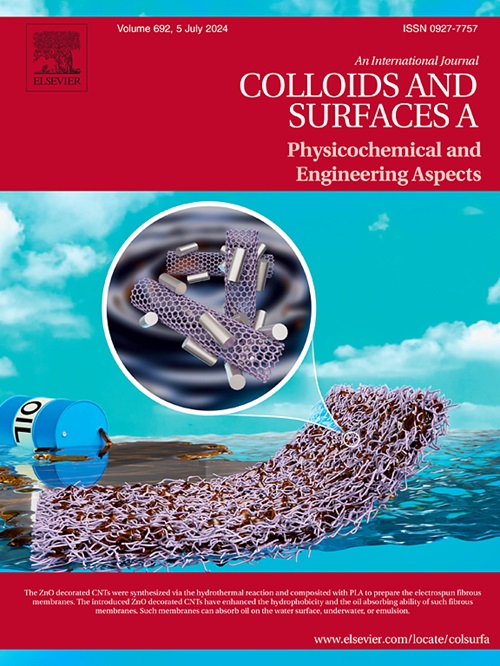TM-SiO2 cross-linked dual-network hydrogel for efficient removal of methylene blue from complex wastewater
IF 4.9
2区 化学
Q2 CHEMISTRY, PHYSICAL
Colloids and Surfaces A: Physicochemical and Engineering Aspects
Pub Date : 2025-07-08
DOI:10.1016/j.colsurfa.2025.137706
引用次数: 0
Abstract
The environmental issues caused by industrial wastewater have prompted wastewater purification to become a significant area of academic research. In this paper, 2-Acrylamide-2-methylpropanesulfonic acid (AMPS) and sodium carboxymethyl cellulose (CMC) were used as double anionic monomers, and vinyl-modified silica (STS) was used as nanofiller and crosslinker to construct nanocomposite double-network (DN) hydrogels AMPS/CMC/STS. The material exhibited an ultra-high adsorption capacity (Qe = 4595 mg/g) and rapid adsorption characteristics (90 % of the equilibrium adsorption capacity within 5 min) for MB (500 mg/L). It maintained a high adsorption capacity under extreme pH (2–11) and in the presence of metal ions due to the significant stability of the dense network structure constructed by the nano-crosslinker and DN structure. Kinetic and thermodynamic analyses indicated that the adsorption process followed quasi-second-order kinetics and the Langmuir isotherm model, confirming that it was dominated by monolayer chemisorption. The absorbent could complete four cycles after acid washing and desorption. Furthermore, the adsorption capacity in simulated natural water bodies (Tap water, Minjiang River water, Guihu Lake water, and Pihe River water) and simulated in real wastewater remained stable at over 3248 mg/g, highlighting its potential application in complex industrial wastewater treatment.
TM-SiO2交联双网水凝胶高效去除复杂废水中的亚甲基蓝
工业废水带来的环境问题促使废水净化成为一个重要的学术研究领域。本文以2-丙烯酰胺-2-甲基丙磺酸(AMPS)和羧甲基纤维素钠(CMC)为双阴离子单体,以乙烯基改性二氧化硅(STS)为纳米填料和交联剂,构建了纳米复合双网络(DN)水凝胶AMPS/CMC/STS。该材料对MB(500 mg/L)具有超高吸附量(Qe = 4595 mg/g)和快速吸附特性(5 min内达到平衡吸附量的90 %)。由于纳米交联剂和DN结构构建的致密网络结构具有显著的稳定性,在极端pH值(2-11)和金属离子存在的情况下,它仍能保持较高的吸附能力。动力学和热力学分析表明,吸附过程符合准二级动力学和Langmuir等温线模型,证实了吸附过程以单层化学吸附为主。该吸附剂经酸洗和解吸后可完成4个循环。此外,模拟天然水体(自来水、闽江、桂湖和郫河)和模拟真实废水的吸附量稳定在3248 mg/g以上,显示了其在复杂工业废水处理中的潜在应用前景。
本文章由计算机程序翻译,如有差异,请以英文原文为准。
求助全文
约1分钟内获得全文
求助全文
来源期刊
CiteScore
8.70
自引率
9.60%
发文量
2421
审稿时长
56 days
期刊介绍:
Colloids and Surfaces A: Physicochemical and Engineering Aspects is an international journal devoted to the science underlying applications of colloids and interfacial phenomena.
The journal aims at publishing high quality research papers featuring new materials or new insights into the role of colloid and interface science in (for example) food, energy, minerals processing, pharmaceuticals or the environment.

 求助内容:
求助内容: 应助结果提醒方式:
应助结果提醒方式:


